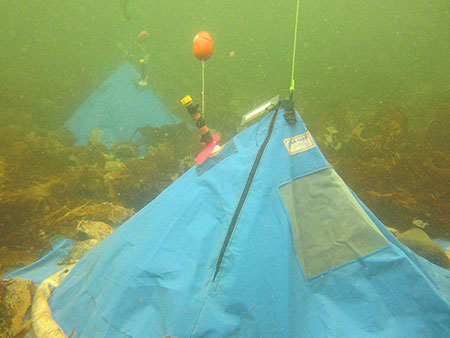You are viewing ARCHIVED content published online before January 20, 2025. Please note that this content is NOT UPDATED, and links may not work. Additionally, any previously issued diversity, equity, inclusion or gender-related guidance on this webpage should be considered rescinded. For current information, visit https://www.blm.gov/blog.
Sea Squirt Invades BLM Submerged Lands in Southeast Alaska
An invasive marine invertebrate known as “marine vomit,” that can smother native species has been found within Whiting Harbor in Sitka. This non-native carpet sea squirt, Didemnum vexillum, (D. vex) is thought to be native to Japan. It was first detected in Whiting Harbor in 2010 as a result of a citizen-science-marine invasive species bioblitz. Tammy Davis, Alaska Department of Fish and Game (ADF&G), invasive species program lead, was concerned along with other stakeholders including local Sitkans and those who work in the marine invasive species world, about the discovery and potential growth and spread of D. vex in Whiting Harbor. Based on growth of the sea squirt on Georges Bank on the east coast of the U.S. and populations globally, Davis feared it would spread into Sitka Sound and then widely along the Alaska coast. She brought ADF&G, the Smithsonian Environmental Research Center (SERC), and the BLM together to begin a plan of action to tackle this invasive species. Managing marine ecosystems is a rare case for the BLM. The intertidal and filled submerged lands within Whiting Harbor were once withdrawn for use by the Navy during World War II and are now managed by the BLM Glennallen Field Office.

D. vex is a filter-feeding marine invertebrate that can form large sheet-like colonies that carpet the seafloor and encapsulate hard structures and stationary organisms. D. vex is an aggressive colonizer that grows rapidly, altering seafloor habitats and fouling shellfish aquaculture, boat hulls, moorings, docks, and boat ramps. There is concern that Pacific herring spawning beds in areas of the infestation could be vulnerable to the acidic outer skin of D. vex, which could have negative impacts on subsistence and commercial Pacific herring fisheries. The Whiting Harbor discovery represents a 620-mile northward leap in distribution from other known occurrences of D. vex in the Northwest Pacific. No other populations are known in Alaska.

D.vex reproduces both sexually and asexually, and can create new colonies through fragmentation and cloning. Lobes break off, drift away in the water column, and settle, thereby establishing new colonies. D. vex is capable of living at a wide range of temperatures, salinities, and depths. These characteristics make it highly invasive and make eradication especially challenging because it can be further spread by recreational boating, marine shipping, drifting on floating material (algae, Styrofoam, debris, or buoys), in-water cleaning of infested boat hulls, or transfer of shellfish stock or aquaculture equipment. The worst case is found in Georges Bank between Canada and the U.S. in the Northwest Atlantic, where it covers an estimated area of 77 square miles. Nonetheless, the Whiting Harbor population lends itself to control. Because it is isolated, it is unlikely that additional larvae will recruit to the area from elsewhere, and currently it is at a manageable scale for eradication.

The ADF&G, SERC, and the BLM have been working together to identify proven and cost-effective eradication methods. Together, they developed a project around a goal to determine if a harbor-wide control treatment is a feasible means to eradicate invasive D. vex from Whiting Harbor and Alaska. In 2015, they conducted trial-run (proof-of-concept) experiments to test equipment and measure concentrations and duration of biocide compounds needed to cause mortality of D. vex. The partners converged on ADF&G’s research vessel the Kestrel. The Kestrel anchored outside of the known D. vex area and was the base of operations for the scientific dive team. Researchers used GPS units to aid in navigating and diving to specific research areas. The divers set-up underwater domes to create a contained area where they could study the effects of biocide agents on the invasive D. vex. Domes were secured to the seabed with anchor chain and sandbags to ensure a good seal to avoid gaps that could dilute the biocides and allow the biocide agents to escape. A different treatment went into each set of replicate domes, including salt, chlorine, and cement dust. Control domes with no treatment were used for comparison. Research divers then returned three weeks later to assess the effects of the various treatments, and compare D. vex mortality by using underwater photos and grid measurements. Data analysis is still ongoing but it’s clear that salt and chlorine were more effective than cement dust for killing D. vex. The type of ocean seafloor (substratum) also appears to have a major influence on treatment’s effectiveness.

While ADF&G, SERC, and the BLM continue to review results of the initial study, they are pursuing funding and working to determine the most effective and cost-efficient next steps for scaling-up eradication efforts. Increasing the spatial scale of treatments is a critical next step that would make a bay-wide eradication attempt feasible. By working together, it looks good that the species will be contained and reduce the possibility of its spread and impact into broader areas of Alaska’s coastline.
Story contributors: Tim Sundlov, Fisheries Biologist and Marnie Graham, Public Affairs, (BLM Glennallen Field Office), Tammy Davis, Invasive Species Program Coordinator (ADF&G), and Ian Davidson, Ph.D (Smithsonian Environmental Research Center)
Marnie Graham, Public Affairs, (BLM Glennallen Field Office)
